Home heating with firewood
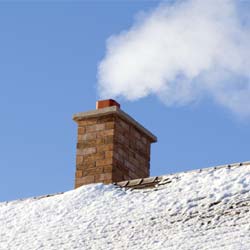 If you have access to free firewood, then using it to heat your home becomes an attractive option.
If you have access to free firewood, then using it to heat your home becomes an attractive option.
In this entry I will explore the different firewood heating methods, and make some calculations for my cottage.
Why firewood?
With so many other heating options, why settle for old technology like firewood?
Cost of heating can be substantial for a home in a Nordic country like Sweden, taking up to a third of the annual home budget. Wood is a cheap energy source when compared to the alternatives:
Birch firewood. Energy content: 2,820 kWh/m3f. Price: 1500 SEK/m3f. Heating efficiency: 85%. Energy price: 0.63 SEK/kWh.
Electricity. Heating efficiency: 100%. Energy price: 1.30 SEK/kWh.
Gasoline/oil. Energy content: 13 kWh/kg (47 MJ/kg). Price: 17.4 SEK/kg. Heating efficiency: 90%. Energy price: 1.49 SEK/kWh.
Propane gas. Energy content: 12.8 kWh/kg. Price: 30 SEK/kg. Heating efficiency: 90%. Energy price: 2.60 SEK/kWh.
Homestead firewood heating is even cheaper than district heating (fjärrvärme), which in Sweden typically is powered by firewood too, and comes at a price of 0.89 SEK/kWh.
Wood is also part of the natural cycle of life, giving carbon dioxide to the atmosphere when it is burned, to be used by new plants to grow and eventually become firewood trees. Sweden is an overall carbon neutral country, with the forests consuming all CO2 produced through various human activity, including firewood heating.
It is cozy to light a fire, so it adds to the atmosphere of the home.
It is fail safe and works at power failures.
If you own a forest you can collect the wood yourself and save away a substantial part of your home budget.
But of course it has its downsides as well. You need to store and handle the firewood. If you source from your own forest you need to spend a week per year cutting and chopping the wood. The fumes are toxic, so the burner and chimney must be in good order. And you need to light a fire once a day.
Types of firewood
In Sweden the dominating firewood is birch. It burns without too much crackling, and it has relatively high energy per volume.
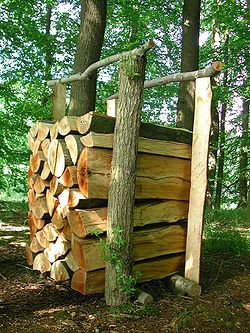 Oak: 3,600 kWh/m3f
Oak: 3,600 kWh/m3f
Maple: 3010 kWh/m3f
Birch: 2,820 kWh/m3f
Spruce: 2,150 kWh/m3f
Pine: 2,150 kWh/m3f
Traditionally the trees are felled in the late winter when sap levels are the lowest. Then if the wood is chopped up before April, it will have dried enough to be used the following fall/winter, but optimally needs two years to fully dry up. A standing tree has a moisture content of around 50%, and usable firewood should be dried to around 20%. Dry wood gives two to three times as much heat as moist wood.
Three different volume measurements are used when the firewood is sold: Solid volume (fast, m3f) is the volume of the wood only. Stacked volume (staplat/travat, m3t) is the volume of a neat stack of firewood pieces. Dumped volume (stjälpt, m3s) is the volume of an unordered pile of wood pieces. These volumes differ a lot: 1 m3f = 2 m3t = 3.2 m3s for the same total weight.
Optimum burn efficiency
A high fire box temperature, a low firewood moisture content, and enough air drag to support the process, will result in an optimum burn efficiency. Burn problems can be identified by examining the fumes coming out of the chimney.
- Transparent or faint white smoke means optimum combustion, resulting in mostly steam and CO2.
- Solid white smoke means good combustion, but too moist firewood.
- Dark and smelly smoke means incomplete combustion, possibly not enough air drag.
- Yellow smoke means tar, possibly from too low fire box temperature and not enough air drag.
History
![]() The most primitive way of heating is a fire pit in the center of a room with fumes escaping through a hole in the ceiling. This was the only source of heat all through the viking age.
The most primitive way of heating is a fire pit in the center of a room with fumes escaping through a hole in the ceiling. This was the only source of heat all through the viking age.
Chimneys were invented in northern Europe in the 11th or 12th centuries, to help lead the fumes out of the room and at the same time act as a heat accumulator. The solid fuel (usually wood) is burned in the fireplace (öppen spis), and the chimney is heated from the fumes. The chimney then radiates the accumulated heat for hours. The efficiency is 5-15%, with most of the heat lost through the chimney.
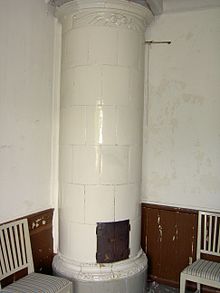
To further improve the accumulation of heat, the masonry heater was invented in the 16th century.
It has a firebox and heat-exchange channels that provide additional surface area. These absorb heat from the fumes before they exit into the chimney. Overall efficiency is around 60%.
Masonry heaters have historically been very popular in Sweden, and are still a coveted decoration item in traditional Swedish homes.
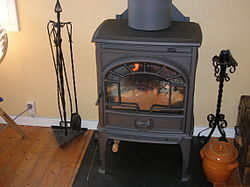 A radiator stove (kamin) is a cast iron stove used as a wood burning radiator, for heating individual rooms. It's very popular in cottages and vacation homes, for quick and temporary heating of rooms, or as a heat booster during really cold weather. Efficiency is around 75%.
A radiator stove (kamin) is a cast iron stove used as a wood burning radiator, for heating individual rooms. It's very popular in cottages and vacation homes, for quick and temporary heating of rooms, or as a heat booster during really cold weather. Efficiency is around 75%.
They are also available as modules to place inside a fireplace, to increase the heating efficiency.
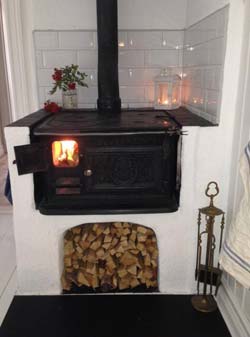 The traditional wood-burning stove (vedspis) is ubiquitous in old Swedish homes. They were introduced in the mid 19th century as a convenient way to cook food, and at the same time heat the room.
The traditional wood-burning stove (vedspis) is ubiquitous in old Swedish homes. They were introduced in the mid 19th century as a convenient way to cook food, and at the same time heat the room.
They are quite sturdy, and can be renovated and reused over and over. Many are still in use today.
Heating efficiency of around 60%.
To make the heating of several rooms more convenient, home owners started using central heating solutions with basement boilers (vedpanna) circulating hot water through radiators placed in the different rooms.
For smaller homes it is usually enough to have a combined boiler and stove (kökspanna) in the kitchen.
Below you can see examples of three heating solutions at Kullfallet: a gas stove for cooking (left), a radiator stove for heating a room (center), and a combined boiler and stove for cooking and heating a small home (right).
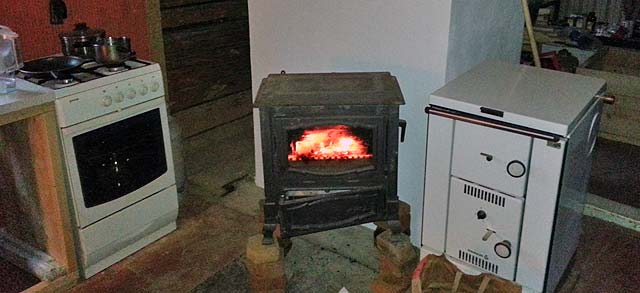
Boiler heating of homes
A stove/burner can normally produce a lot of heat during a short time (2-3 hours) while the wood burns, but a home typically needs a low heat source for a long time (24 hours). To solve this mismatch a thermal storage tank (ackumulatortank) is used. The stove heats the water in the tank for a few hours, which then heats the house throughout the day.
Basic configuration
See the picture below for the most basic configuration. The water circulates in a loop through the system. With a really large pipe diameter (2" or more) the water can circulate by its own force, but normally smaller pipes and a circulation pump are used. This is also an example of a one-pipe radiator configuration, where most of the hot water passes by each radiator and a smaller portion flows into it. This is controlled by a mix valve on each radiator, which can be manual or thermostat. In this configuration, water constantly flows through the circuit, even when indoor temperature is high and no heating is required.
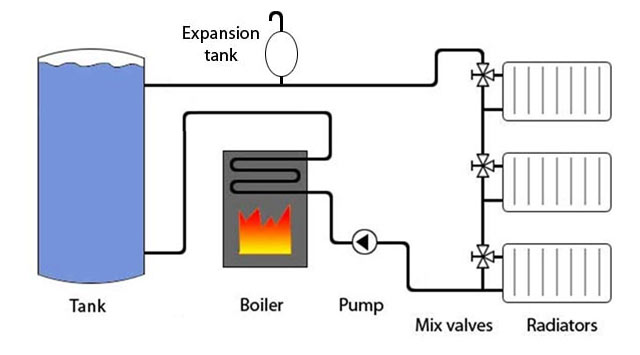
The system has a moderate performance, mostly because cold water is pumped into the boiler, which keeps the fire box temperature low.
Modern configuration
A more efficient system can be seen below. Instead of one long circuit, there is now one loading circuit, and one radiator circuit, each powered by its own pump. When the boiler is fired up, the load pump is turned on, and the thermostatically controlled load valve diverts the output from the boiler back to the input again. This short loop makes the temperature of the water rise quickly. When it reaches 70 C, the load valve starts to mix in water from the tank. This arrangement keeps the boiler temperature high and even, while the tank is filled from the top with 80 C water.
Unlike the previous system, the water in the tank does not have an even temperature from top to bottom. Instead it has two distinct layers with different temperatures, and this is important to optimize performance. The flow into the tank should be kept at a minimum to not disturb the layering, and it should be water of the correct temperature only.
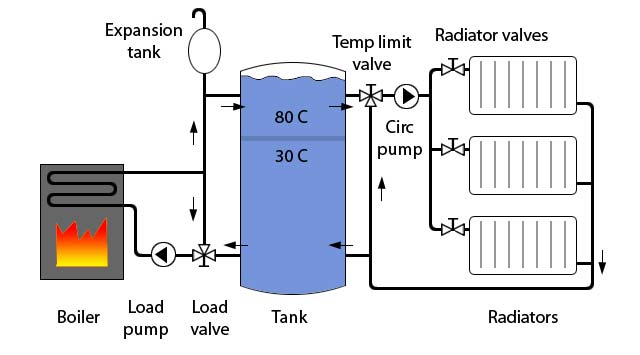
The radiator circuit also uses a thermostatically controlled valve together with a circulation pump, but this time to lower the temperature from 80 C down to 55 C, which is more suitable for radiators. The cold water returned from the radiators is mixed with hot tank water and pumped back through the radiators. The hotter the return water is, the more of it is sent back to the radiators, making sure that only fully used up water enters the bottom of the tank.
The above is is an example of a two-pipe radiator configuration, where the radiators are connected in parallel, and each radiator valve can completely close the flow, typically using thermostats. If the house gets sufficiently hot, all radiator valves will close up and there will be no flow in the circuit. The pump senses this and goes to into standby.
A temperature layered tank has larger useful heat capacity than a tank with even temperature. This because the temperature at the top is always 80 C, from fully loaded all the way to the end of being used up. For the even temperature tank, the temperature gradually falls, and when it reaches around 40 C it still contains heat energy, but it is not hot enough to be useful in the radiators.
A modern system like this has a total heat efficiency of around 85%.
Expansion tank
This tank holds the excess water from heat expansion. Going from 20 C to 80 C will expand the water volume by 3 %. In Sweden the rule of thumb is to use an expansion tank that is 5% of the total circuit volume.
The heating system can either be open or pressurized. For an open system, you must place the expansion tank at the highest point of the circuit (typically in the attic), and it must have an open overflow pipe at the top for emergencies. No safety valve is needed.
For a closed system, the expansion tank can be mounted anywhere in the circuit, and it contains a rubber bladder that absorbs the water expansion. As water is heated, pressure is created inside the circuit, so all parts must be 100% water tight, and a safety valve must be installed.
Pipes
Traditionally steel pipes with threaded ends were used, and later copper pipes with brazed fittings. Now it is more common with compression fitting or crimping, and using plastic covered copper (Prisol), or plastic PEX pipes. Soldered copper pipes still look the best and the joints feel more solid and trustworthy, but it is the most expensive method, and the brazing process is a fire hazard. PEX is also more flexible and faster to install, which makes it the default pipe type in modern homes.
System calculations
These are calculations for my cottage Kullfallet. I have not yet decided to implement the full system, since it is considered overkill for such a small cottage. A radiator stove is typically all you need for a well insulated small house.
Radiator sizes
A typical Swedish home needs around 70 W of heating per square meter of floor area to feel comfortable in the winter. This assumes normal ceiling height and typical wall insulation. In my case, this means a 1000 W radiator for the kitchen/living room (15 m2), a 700 W radiator for the bed room (10 m2), and a 350 W radiator for the bathroom (5 m2), or in total around 2 kW. For spring and fall this will be around 1 kW, and in the summer close to 0 kW.
Tank size
Swedish homes typically use two or three 500 L tanks in their system, but since my house is so small I can get away with a lot less.
The specific heat of water is 4.2 kJ/kg C, which means that raising the temperature of one kg of water one degree C requires 4.2 kJ of heat energy.
A 300 L thermal storage tank, with a water temperature of 80 C, has an energy content of: E = 300 kg x 4.2 x (80 C - 30 C) = 63,000 kJ or 17.5 kWh. This means that during spring and fall, I would need to burn a fire once a day, and in the winter twice a day, which is practical enough.
Padding the tank with an insulation material will lower the temperature loss in the tank. Mineral wool has a K-value of 0.04 W / m2 C per 1m thickness. Using a 0.1 m thick sheet gives a K-value of: K = 0.04 / 0.1 = 0.4 W / m2 C. A 300 L tank has a surface area of around 3.5 m2. The heat loss through the insulation material becomes: P = 3.5 m2 x 0.4 x (80 C - 20 C) = 84 W. In other words, when fully loaded with 80 C hot water, the insulated tank will act as a 84 W radiator. Manufacturers typically state this value to around 100 W.
Boiler size
The second hand Wamsler boiler/stove I bought last year has a rating of 20 kW, so in theory I can heat up the 300 L tank in one hour. But more likely I will shrink the fire box and burn at a slower pace to let it take 2-3 hours.
Pipe sizes
Pipe sizes can be calculated in detail if you know the volume of flow, pipe resistance, etc, but the rule of thumb says: The loading circuit uses 28 mm (1") pipes or in extreme cases 35 mm (1.5"). The stems of the radiator circuits use 22 mm (3/4") and the individual radiator circuits use 18 mm (5/8") or 15 mm (1/2"). The larger the pipe, the less flow resistance, and the less the circulation pump has to work, but of course the price increases.
